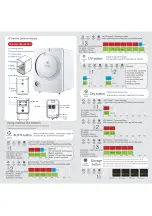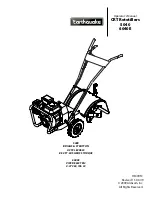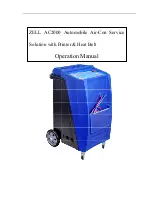
© 2017 by Hettich AG
page 32
CW II-OM-rev1.1
Hettich AG
Laborapparate
phone:
+41 44 786 80 20
Seestrasse 204a
e-mail:
CH-8806 Baech
internet:
www.hettich.ch
12.2
Rotor
•
It is important that the rotor is kept clean and free from dried up salt crystals and other deposits.
•
Either soak the rotor in warm, distilled water or pour the water directly down into the rotor for a few minutes. The
water must flow out of all the injection nozzles.
•
If the injection nozzles are blocked, insert the included plastic pin into the injection nozzles and carefully slide it
in and out until the nozzles become clear again.
•
In order to prevent corrosion and material changes, rotors and accessories must be cleaned regularly with soap
or a mild detergent and a damp cloth. Cleaning is recommended at least once a week. Contaminants must be
removed immediately. Ingredients of suitable detergents:
soap, anionic tensides, non-ionic tensides.
•
After using detergents, remove detergent residue by rinsing with water (only outside of the centrifuge) or wipe
off with a damp cloth.
•
The rotors and accessories must be dried directly after cleaning.
•
Disinfection:
−
If infectious material should get on the rotors or accessories, they must be appropriately disinfected.
−
Ingredients of suitable disinfectants:
glutaraldehyde, propanol, ethyl hexanol, anionic tensides, corrosion inhibitors.
−
After using disinfectants, remove disinfectant residue by rinsing with water (only outside of the centrifuge) or
wipe off with a damp cloth.
−
The rotors and accessories must be dried directly after disinfection.
−
Removal of radioactive contaminants:
−
The agent must be specifically labelled as being an agent for the removal of radioactive contaminants.
−
Ingredients of suitable agents for removing radioactive contaminants:
anionic tensides, non-ionic tensides, polyhydrated ethanol.
−
After removing the radioactive contaminants, remove agent residue by rinsing with water (only outside of the
centrifuge) or wipe off with a damp cloth.
−
The rotors and accessories must be dried directly after removing the radioactive contaminants.
−
The rotor is to be checked for corrosion damage every month.The rotor is to be checked for corrosion damage
every month.
If there are signs of wearing or corrosion, the rotors and accessories must no longer be used.
12.3
Autoclaving
The system must be regularly disinfected and cleaned, refer to Chapter 12.6 Clean system
None parts from the device and its accessories are made for autoclaving
12.4
Removal of the drain gutter
The drain gutter and the covering ring can be removed from the bowl, centrifugation area, fig. , pos. 3, for cleaning.
Removal of the grain gutter and the covering ring:
•
Remove the covering ring (fig. 3, pos.) from the bowl.
•
Carefully flap the inner sealing ring (fig. 3, pos.) upwards and remove the drain gutter (fig. 3, pos.) out of the
centrifugation area.
•
Insertion of the drain gutter and covering ring:
at the back of the centrifugation area carefully flap the sealing ring (fig. 4, pos.) upwards and push the drain
gutter (fig. 4, pos.) under the sealing ring (fig. 4, pos.
The drain hole of the drain gutter (fig. 4, pos.) must be located above the drain hole (fig. 4, pos.) in the bowl.
•
Carefully flap the sealing ring (fig. 4, pos.) upwards around the drain gutter on the inside and press the drain
gutter (fig. 4, pos.) downwards. The drain gutter (fig. 3, pos.) must be located below the sealing ring (fig. 3,
pos.).
•
Place the covering ring (fig. 3, pos.) on the drain gutter in such a way (fig. 3, pos.) that the inscription "this side
up" can be read, refer to fig. 3, pos.
12.5
Clean system with cleaning solution
•
Prepare in a beaker about 400ml of 0.5% sodium hypochlorite cleaning solution.
•
Take off the supply hose from the physiological saline solution container and dipping it it to the beaker with the
0.5% sodium hypochlorite cleaning solution
•
Rinse and fill the system with cleaning solution using the flush 1 program








































